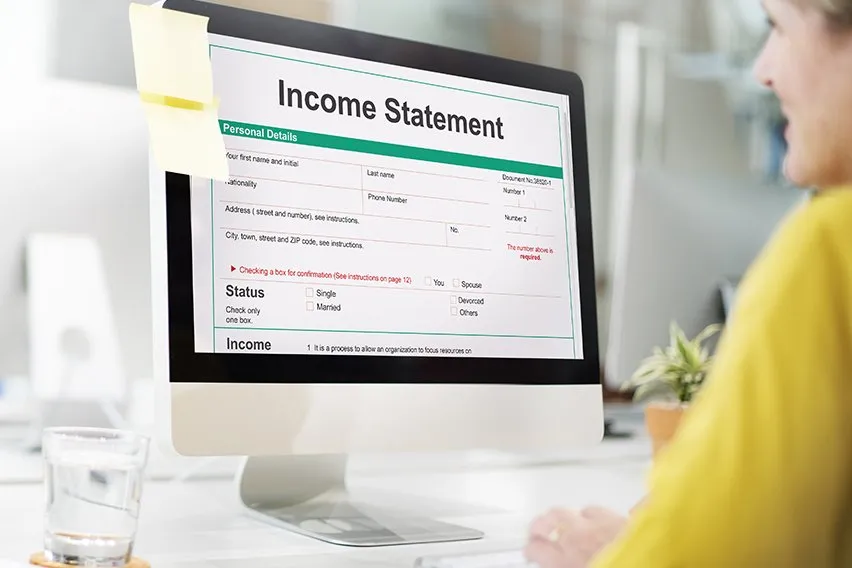How To Calculate Net Profit Margin: Formula and Example

For small businesses, understanding net profits is instrumental to success. Accurately calculating your net profit margin will help you better understand your business’s financial health, measuring how much of your sales represent actual profit after accounting for expenses like the cost of goods sold, operating costs, taxes, and debts.
Understanding how to calculate your net profit margin will help you evaluate your company’s performance, guiding future business decisions and supporting the overall management of your finances.
In this guide, we’ll go over everything you need to know about your net profit margin. We’ll explain the process of net profit margin calculation using your business’s income statement, how to interpret the net profit margin to evaluate your financial position, and how to use this data to improve your company’s bottom line.
Key Takeaways
- Your net profit margin tells you what percentage of your revenue is real profits after all expenses have been paid.
- The formula for calculating your net profit margin subtracts all expenses from your total revenues and then divides that figure by revenues again to arrive at your net profit margin.
- Net profit margins can be used to track a company’s financial health, evaluate business practices, and measure profitability changes over time.
- Accounting software can make it much simpler to regularly calculate your small business’s net profit margin.
Table of Contents
- What Is Net Profit Margin?
- Net Profit Margin Formula
- How To Calculate Net Profit Margin (With Example)
- Net Profit Margin Interpretation
- What Is the Importance of Net Profit Margin?
- Net Profit Margin Ratio Limitations
- Conclusion
- Frequently Asked Questions

What Is Net Profit Margin?
Net profit margin (also called your net margin) is a way to measure how much net income or profit your business is generating. It’s calculated as a ratio of your overall revenue for a company or a specific business segment.
Net profit margins are usually written as a percentage but they may also be represented as a decimal. In either case, your net profit margin will show you how much of each dollar your company generates in revenue is actual profit that you can keep.
Net Profit Margin Formula
The net profit margin formula looks a little complex, but it’s actually quite straightforward.
Mathematically, the formula is laid out like this:
Net profit margin = ((R – COGS – E – I – T) / R) X 100
Or more simply, you could lay it out like this:
Net profit margin = (Net income / R) X 100
Here’s what all those letters mean:
- R – Revenue
- COGS – Cost of Goods Sold
- E – Operating/Other Expenses
- I – Interest
- T – Taxes
Still not sure how the formula works? Let’s break down the calculation process step-by-step.
How To Calculate Net Profit Margin (With Example)
The process of calculating your net profit margin is much simpler than the formula may seem. Here are the steps to doing it quickly and easily:
- Begin with your gross revenue for a given period (this is found on your income statement)
- Subtract the cost of goods sold (COGS), operating/other expenses, dividend payments (if applicable) any interest you owe, and any taxes you’ll have to pay from your gross revenue
- Now you’ll have your net income
- Divide net income by revenue
- Multiply the number you get from step 4 by 100 to convert it into a percentage
- You have your net profit margin, expressed as a percentage
To make it even simpler, we’ll use an example to give you a sense of how this calculation might work for a real business.
Our example company is called Bob’s Books. In 2024, they sold 50,000 units of its product, at a cost of $10 per unit. The cost of goods sold (COGS) for this product was $6 per unit. Bob’s Books’ operating expenses for 2024 totaled $25,000, and they paid $30,000 in taxes. Here’s how we would calculate net profit margins for Bob’s Books in 2024:
- Find total revenue by multiplying the number of units sold by the selling price per unit
- $50,000 X 10 = $500,000 is our total revenue
- Next, we calculate net income by subtracting expenses from the total revenue—in this example, Bob’s Books’ expenses are COGS, operating expenses, and taxes
- We calculate COGS by multiplying units sold by the cost of making one unit: $6 X 50,000 units = $300,000 in COGS
- We then add up all of our expenses: $300,000 (COGS) + 25,000 (operating expenses) + $30,000 (taxes) = $355,000 in expenses
- Then, we subtract expenses from our total revenue to get our net income: $500,000 (total revenue) – $355,000 (expenses) = $145,000 (net income)
- Lastly, we calculate Bob’s Books’ net profit margin by dividing net income by total revenue, and then dividing that number by 100 to express it as a percentage:
- $145,000 (net income) / $500,000 (total revenue) = .29
- .29 X 100 = 29
- Bob’s Books’ net profit margin is 29%
Net Profit Margin Interpretation
Now that you understand how to calculate your net profit margin, how do you interpret that number and use it to make financial decisions? Provided your net margin is expressed as a percentage, interpreting it is simple. Say your net margin is 29%, as in our example above—this means that for every dollar your company generates in total revenue, 29 cents are real profits. The other 71 cents per dollar are going towards your expenses.
A single net profit margin doesn’t tell you much about your company’s financial health. The real benefit comes when you regularly calculate your net margin. By tracking increases and decreases in this number over time, you can evaluate whether your current business practices are working, or if they’re causing your company to lose money.
Net margins can also be used to forecast future profits based on revenues, to compare two different companies of a similar size and type, and to determine if overhead and operating costs are eating up too much of your business profits.
What Is the Importance of Net Profit Margin?
Your net margin is a vital indicator of the financial health of your small business. It’s a simple way to see how much real profit you generate from your sales after expenses have been accounted for. In other words, it tells you how profitable your business is.
Over time, tracking this net profit margin will help you determine if your practices are working. If you hire more staff to make more products more quickly, this is an expense in the hopes of making more profit. Tracking your net profit margin after making a change like this can tell you whether your idea is working or not.
Your net profit margin is also a key part of the approval process for small business loans. Lenders will look at this figure (along with other key financial reporting information) to determine whether or not to loan money to your business. Naturally, a higher net profit margin means you’re more likely to get a loan since it indicates higher cash flow and profitability.
Net Profit Margin Ratio Limitations
Your net profit margin ratio is a great reporting tool, but it has limitations. For example, if your business makes a large, one-off transaction (e.g., selling a major asset), it can skew your net profit margin, making your business appear much more profitable than it is.
There are other potential issues with net margins—it doesn’t provide much information on the growth of your revenue or sales, and it doesn’t give insight into your production costs. Because of these limitations, your net profit should be compared with other reports, such as your operating profit margin and gross profit margin to get the full picture of your business’ financial health.

Conclusion
When it comes to running a small business, knowledge is power. Calculating your net profit margin provides important knowledge for small business owners, helping you gauge your profitability and financial position. Of course, your net margin can only help you if you can reliably and consistently calculate it.
Accounting software is a great tool for efficiently keeping track of revenue and expenses throughout the year. Great tracking means it’s much easier to calculate your net margin in seconds, helping you make crucial business decisions and pushing your company to new heights. Try FreshBooks free today.
FAQs About How To Calculate Net Profit Margin
Still curious about calculating and interpreting your net margin? Here are a few frequently asked questions.
What is a good net profit margin ratio?
What’s considered a good net profit margin ratio depends on your industry and specific business plan. But a good rule of thumb is to compare it to a benchmark index like the S&P 500. In Q4 2024, the S&P 500’s net margin was 11.2%. 1
What is the difference between net profit and gross profit?
Net profit refers to the amount of money you have left after paying all business expenses (e.g., taxes, operating expenses, etc.), whereas gross profit is the amount you have left after only paying for your cost of goods sold (COGS). You’ll need to calculate gross profit to calculate net profit.
How do you increase your net profit margin?
There are 2 ways to increase your net profit margin: increasing revenues (e.g., selling more units, increasing prices) or reducing expenses (e.g., cutting back on labor or costs of goods sold). Most businesses looking to increase their net margin use both of these approaches simultaneously.
How do you calculate net profit margin from an income statement?
Your income statement should show your net income (total revenue minus expenses) at the bottom. Simply take this number and divide it by your total revenue to get a decimal number. Then multiply this number by 100 to express it as a percentage. This is your net profit margin.
How do you calculate net profit margin from a balance sheet?
To calculate your net margin with a balance sheet, you’ll need to calculate your total real revenues from the ‘assets’ section. Make sure to only calculate revenues you actually received in cash. Then, subtract your real expenses from total revenue to get your net profit. Divide net profit by revenue, then multiply by 100 to get your net profit margin.
Article Sources
- FACTSET. “S&P 500 Reporting Higher Net Profit Margin Quarter-Over-Quarter for Q1” Accessed October 28, 2024.
Reviewed by
Jami Gong is a Chartered Professional Account and Financial System Consultant. She holds a Masters Degree in Professional Accounting from the University of New South Wales. Her areas of expertise include accounting system and enterprise resource planning implementations, as well as accounting business process improvement and workflow design. Jami has collaborated with clients large and small in the technology, financial, and post-secondary fields.
RELATED ARTICLES



 What Are Assets and Liabilities: A Primer for Small Businesses
What Are Assets and Liabilities: A Primer for Small Businesses Accounting for Entrepreneurs: A Guide for Small Business
Accounting for Entrepreneurs: A Guide for Small Business What Is a Journal Entry in Accounting?
What Is a Journal Entry in Accounting? What Is the Difference Between Cash and Accrual Accounting?
What Is the Difference Between Cash and Accrual Accounting? Single-Step vs Multi-Step Income Statement: Key Differences for Small Business Accounting
Single-Step vs Multi-Step Income Statement: Key Differences for Small Business Accounting How to Calculate Manufacturing Overhead Costs
How to Calculate Manufacturing Overhead Costs